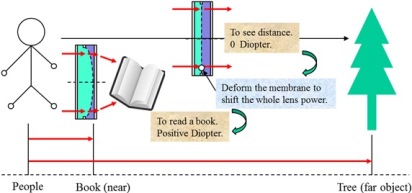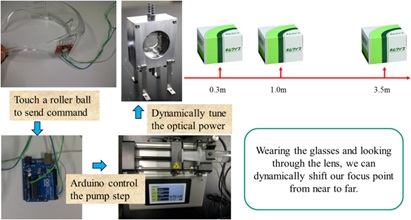A pair of diopter-adjustable eyeglasses for presbyopia correction
Summary
Presbyopia is a natural occurring ophthalmic disease. Most people start to experience vision difficulties, when over 40 year of age. These are most noticeable when reading material at close range, such as books or newspapers: it appears necessary to hold them farther away than before to achieve clear focus. A menu in a restaurant may appear blurred, especially under dim light. This inability of the eye to focus sharply on nearby objects, resulting from loss of elasticity of the crystalline lens and the loss of power of the ciliary muscles with advancing age, is called presbyopia.
Presbyopia is unlike myopia and hyperopia: the latter two can be simply corrected by adding or subtracting a fixed amount of optical power through corrective glasses, while in presbyopia, the loss of elasticity of the crystalline lens affects and reduces the eye's accommodation power. Therefore, a fixed lens cannot correct presbyopia.
Population ageing is a phenomenon that due to rising life expectancy and declining birth rates. According to the survey, China and Japan will be facing an unbalanced population growth resulting in an aging society in the next coming decade. According to the pathogenesis of presbyopia, most of them will suffer presbyopia. Furthermore, in the worldwide it is predicted that the prevalence of presbyopia will increase to 1.4 billion people from the total of 7.7 billion by 2020, and to 1.8 billion people of the whole population of 9.6 billion by 2050. As a result their ability to complete important daily tasks is restricted. Most (386 million, or 94 percent) live in the developing world. A massive number of people cannot work or read properly because they do not have vision corrections, with an obvious enormous impact in their everyday life.
We propose here a pair of diopter-adjustable glasses providing a uniform optical power over the whole lens cell; Optical power can be controlled by the wearer through a miniature roller ball attached to the right bridge of the glasses; opposite rolling directions cause a rapid, positive or negative step-by-step change on the optical power. Our preliminary experiments demonstrate that it should be possible to use this system as a pair of active correction glasses for presbyopia.
In figure 1, a variable focus glasses provides tunable diopters to correct presbyopia; the wearer can observe far and near objects in sharp focus by adjusting the lens power interactively. The experimental setup is shown in figure 2. Three objects were placed at different distances away from the glasses - respectively 0.3 m, 1.0 m, and 3.5 m (standing from far, middle and near targets). The glasses are fitted with a touchable interface sensor (roller ball) whose output is polled using a microcontroller connected via a serial port with a computer. The computer will process the signal and sends commands to a pump controller that actuates a high precision syringe pump. Experimental results can be found in figure 3, which were three snapshots from a video recording.

|

|
| Figure 1. A cencept of a pair of diopter-adjustable eyeglasses. | Figure 2. An experimental setup and three objects signs for far-middle-near. |
|---|---|

|
|
| Figure 3. Three snapshots from a video recording. | |
References
- Lihui Wang, Alvaro Cassinelli, Hiromasa Oku, Masatoshi Ishikawa, A pair of diopter adjustable eyeglasses for presbyopia vision correction, SPIE Optics + Photonics 2014 (San Diego, California, USA, 2014.08.18) / Proc. of SPIE, Vol.9193, 91931G-1(Poster Session)[PDF(0.5M)][Poster(0.4M)][DOI:10.1117/12.2061659]
- Lihui Wang, Hiromasa Oku, Masatoshi Ishikawa, An improved low-optical-power variable focus lens with a large aperture, Optics Express, Vol.22, Issue 16, pp. 19448-19456 (2014)[PDF(2.2M)][DOI:10.1364/OE.22.019448]
- Also selected for the Virtual Journal for Biomedical Optics, Vol.9, Issue 10 (2014)
- Lihui Wang, Hiromasa Oku, Masatoshi Ishikawa, Variable-focus lens with 30 mm optical aperture based on liquid--membrane--liquid structure, Applied Physics Letters, Vol.102, 131111 (2013)[PDF(1.1M)][DOI:10.1063/1.4800603]*AIP
*AIP © 2013 American Institute of Physics. This article may be downloaded for personal use only. Any other use requires prior permission of the author and the American Institute of Physics. The article appeared in L. Wang et al.,Appl. Phys. Lett. 102, 131111 (2013) and may be found at http://link.aip.org/link/?APL/102/131111.



